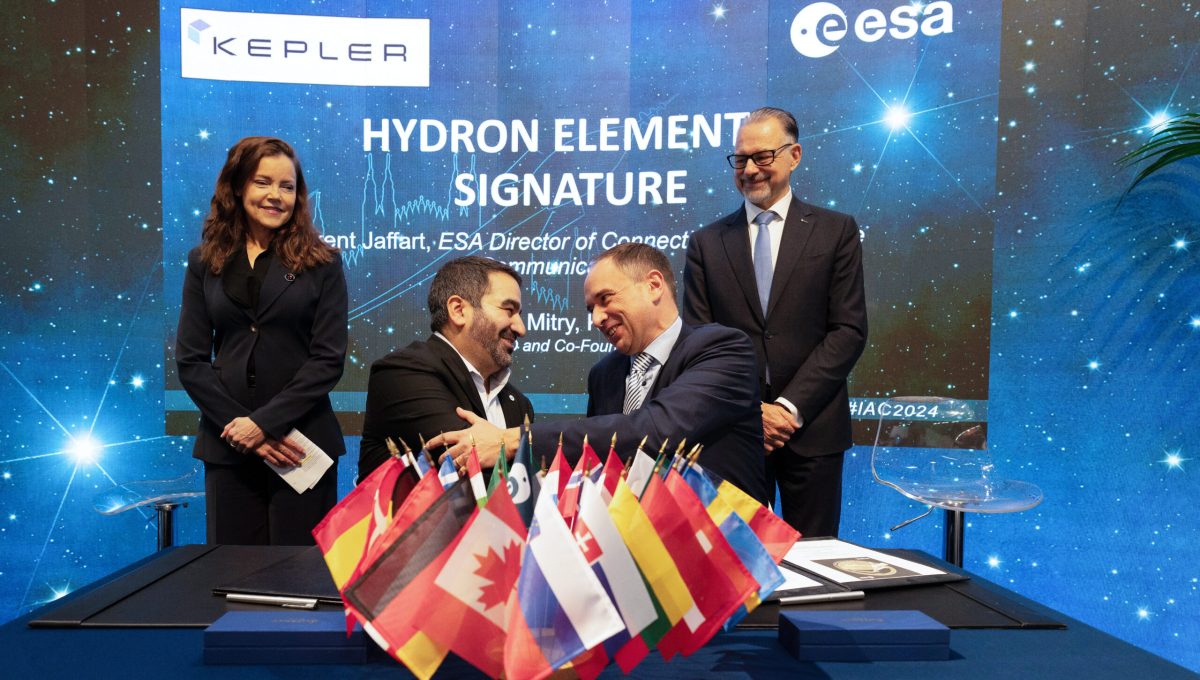TAMPA, Fla. — The European Space Agency has awarded a group led by Kepler Communications, a Canadian small satellite operator, a 36 million euro ($39 million) contract to develop a low Earth orbit (LEO) optical relay network.
The three-year contract covers early design work for the LEO phase of ESA’s High Throughput Optical Network (HydRON) program, a multi-orbit, terabit-per-second transport system that would extend the reach of terrestrial fiber networks.
Kepler and ESA signed the contract for Element #1 of the HydRON-DS (Demonstration System) during a ceremony Oct. 16 at the International Astronautical Congress in Milan.
Mina Mitry, Kepler’s CEO, said the group expects to support a follow-on, two-year demonstration phase from 2027 to test the sovereign “fiber in the sky” optical connectivity plan.
“The HydRON ring will have 9 optical satellites with 1 spare on-orbit,” a Kepler spokesperson added via email.
“Additional rings can be considered for future funding stages.”
Kepler previously served as a subcontractor in two competing groups that secured ESA contracts in 2022 to conduct feasibility studies for HydRON: one led by Airbus and the other by Thales Alenia Space.
The Canadian company was promoted earlier this year to lead the Airbus group, which also includes the French manufacturer’s independent laser terminal subsidiary Tesat-Spacecom, to leverage Kepler’s separate plans for an optical relay network geared for LEO satellite operators.
The Kepler Network aims to streamline on-orbit communications with a network infrastructure designed to act as Internet exchange points (IXP) for space-to-space data relay. Credit: Kepler CommunicationsUsing a fleet of 21 sun-synchronous small satellites, Kepler currently offers low-data-rate connectivity for devices beyond the reach of terrestrial networks as its primary service.
In June, the operator announced it successfully tested optical inter-satellite links between a pair of prototypes deployed to LEO last year for a new data relay business.
The prototypes transferred terabytes of data during scenarios simulating anticipated demand from other LEO operators, which would use the relay network to gain real-time connectivity for spacecraft that would otherwise have to wait to pass over an approved ground station.
The relay network would be deployed across two near-orthogonal planes in sun-synchronous orbits to keep line of sight with LEO spacecraft.
Kepler aims to produce 10 data relay satellites at its Toronto facility and deploy them by the end of 2025, also including one spare, as part of the first tranche of its relay strategy in support of LEO spacecraft.
“Tranche-2 will be upgraded with updated payloads to serve both Kepler’s objectives and those of the HydRON mission,” the Kepler spokesperson said.
“This includes technology that will greatly increase the data rates of links between LEO spacecraft, LEO to Ground, and potentially to other orbits.”
Kepler aims to operate a total of 140 satellites, gradually incorporating new technologies as the network expands.
